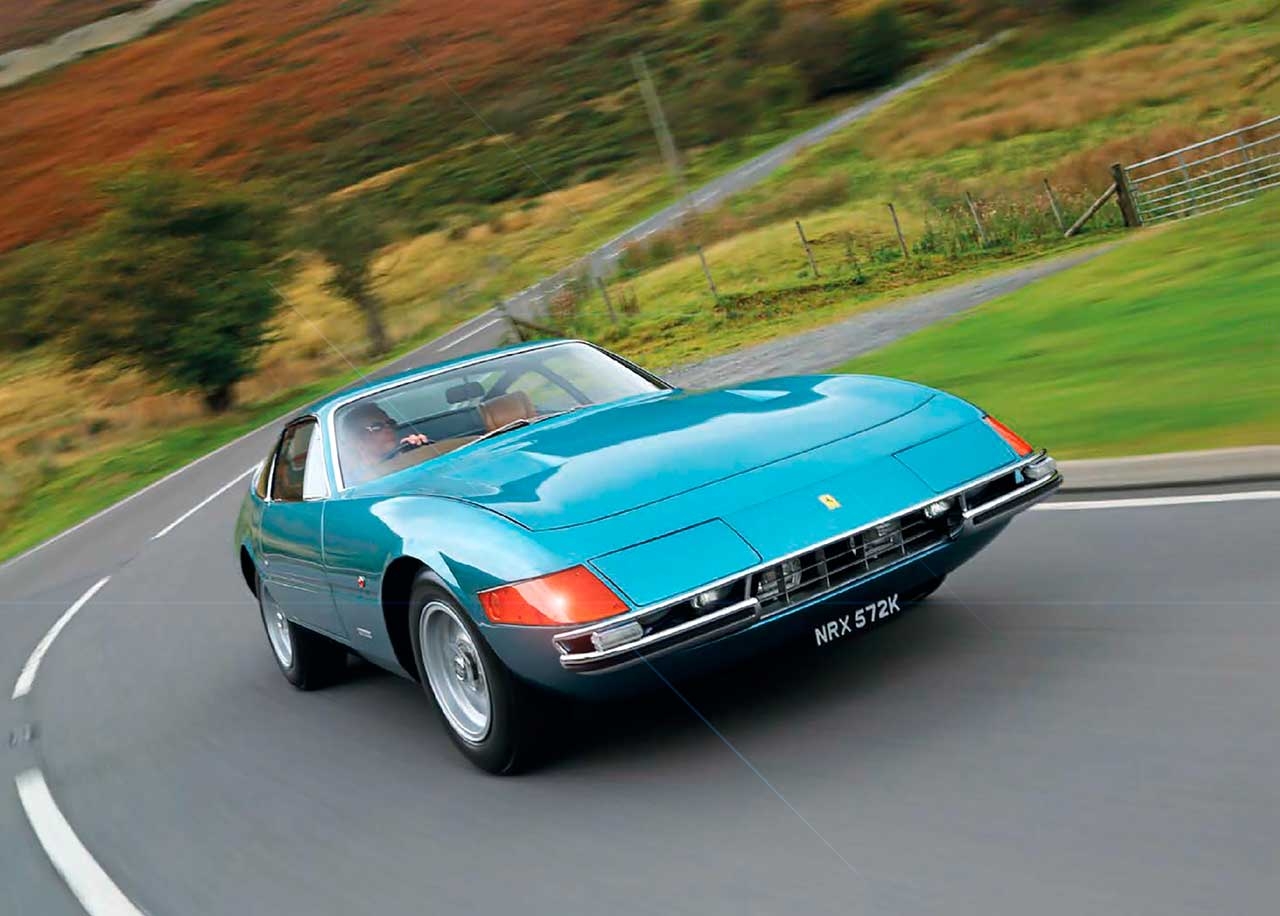
Bred of heaven. The 365GTB/4 Daytona confounds its critics on twisting mountain roads. Daytona rediscovered. Richard Heseltine takes a 365GTB/4 to the winding roads of Wales and is left bewitched by the experience. The Daytona didn’t break any moulds but reigned as the world’s fastest car for a decade-plus, says Richard Heseltine as he discovers motoring nirvana in Wales. Photography Julian Mackie.
Paradise, a word used promiscuously by travel writers, is to be found in north-east Wales. Or, to be specific, on the A542 from Llandegla to Llangollen that bisects the Horseshoe Pass. This ribbon of asphalt that snakes up hill and down dale is a thing of wonder. Lengthy straights, tricky corners, camber changes and attention-focusing drops are enough to induce wide-eyed incredulity. Except there’s the nagging sense that we may have brought the wrong tool for the job. Something light and agile would have been a better choice, surely? The Ferrari 365 GTB/4 – or Daytona to use its unofficial tag – is a truck. Everyone knows that.
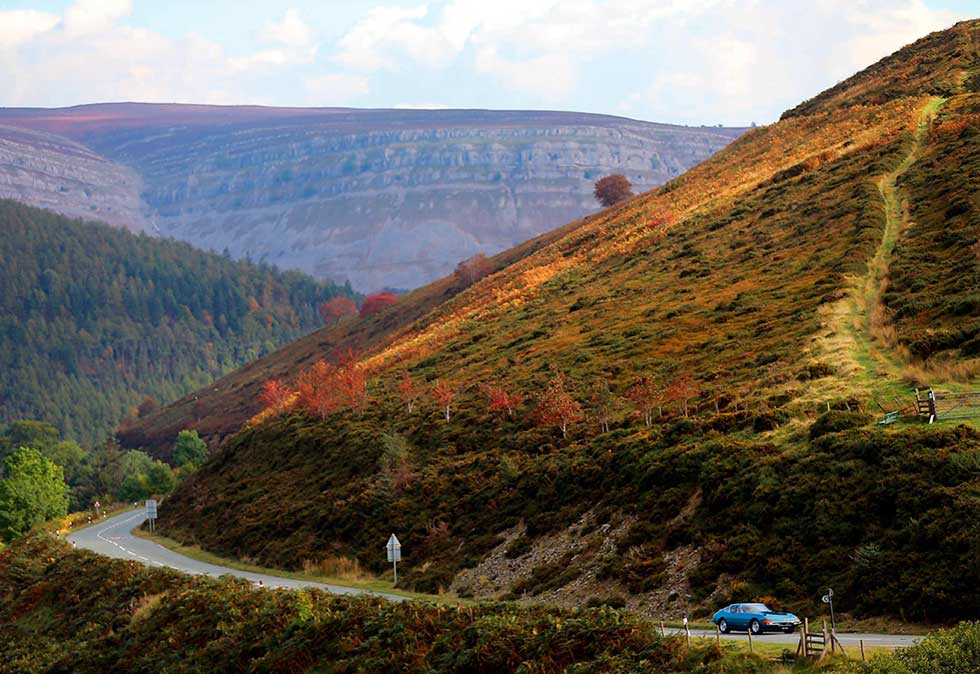
Well, it all rather depends on your definition of ‘truck’. As of right now, it’s hard to pin down an emotion to feel as this big-boned GT gnaws its way through the countryside. Half a century may have elapsed since the model was conceived – stylist Leonardo Fioravanti having conjured the Daytona in one sleep-deprived week – yet it continues to polarise opinion. Generally, that is, among those who haven’t actually driven one, even if there is a sliver of an iota of a nuance to the commercial vehicle analogy.
It’s worth remembering that the superlatives garnered by this super-coupé have been earned the hard way. It certainly wasn’t met with widespread acclaim when the dustsheets were lifted at the 1968 Paris Salon. The 365GTB/4 was coolly received, upstart start-up Lamborghini having already stolen Ferrari’s thunder with the radical Miura. Its mid-engined layout represented the future – the template for all subsequent performance car legends, if only in the eyes of most motoring writers of the period. The Daytona was boringly orthodox in comparison. The thing is, Ferrari wasn’t shooting for the stars. Proven foundations underpinned its new range-topper.
As such, it worked infinitely better than its technically daring rival, which was still in the throes of development even after it went on sale. The Daytona featured a steel chassis onto which the engine and suspension were hung, with a smaller framework supporting the radiator, unstressed body panels and the glassfibre ‘tub’ that also formed the sills plus the front and rear bulkheads, all bonded together to make one unit. Bodies were fabricated the old-school way, with Scaglietti’s hammer-wielders shaping panels over wooden bucks before welding them together. Power came from a 4390cc quad-cam V12 fed by six twin-choke Weber carbs that, if Ferrari’s figures are to be believed, translated into a useful 353bhp at 7500rpm. That, and 318lb ft of torque at 5500rpm. Enough of the good stuff, basically, for the Daytona to be just about the fastest car on sale in period. Or rather, the quickest where performance claims were independently verified. In ’1971, Autocar managed 0-100mph in 12.6 secs on the way to a top speed of 174mph – which was heady stuff.
Ferrari followed up with the open GTS/4 variant in late 1969, the Daytona also proving an effective, if improbable, competition tool. Class wins were accrued at blue chip events such as the Le Mans 24 Hours, to say nothing of Jean- Claude Andruet’s outright victory on the 1972 Tour de France Automobile. The North American Racing Team also fielded them in record attempts at Bonneville, with screen idol Paul Newman on the driver roster. Competizione editions were still in the mix as late as 1979, when Otto Zipper’s example upheld Ferrari honour in the Daytona 24 Hours by finishing second behind a Porsche 935. That was a full five years after production ended, let’s not forget, by which time 1279 fixed-heads had been built – along with 122 ragtops (of which only seven were ever made in right-hand drive configuration).
Even now, it’s hard not be smitten by the visuals, especially when the Daytona is resplendent in Blu Chiaro Metallizzato as here. Its magnetism hasn’t been diminished by familiarity, that’s for sure. Fioravanti’s styling genius came into full flower with what was, after all, a personal project (see panel). His rather slender CV at the time of the Daytona’s creation consisted of the 250LM’s roofline, although he was also engaged in transforming Aldo Brovarone’s Dino concept into the 206GT production car. This was his calling card; his springboard to greatness. There simply isn’t a line wrong on the Daytona, its priapic nose, deceptively rounded flanks and taut roofline conspiring to produce what was arguably the last genuinely beautiful Ferrari grand tourer, save perhaps for the 365GTC/4.
Beauty isn’t merely skin deep, either. It’s hard not to come over all Johnny Jet-Set when confronted with the tan leather seats and alloyspoked steering wheel. Plus, the view through the shallow windscreen and across the vast acreage of bonnet seems to stretch as far as the eye can strain. It isn’t ergonomically brilliant, which goes with the territory, but you don’t feel like a benumbed contortionist, either. The wheel is moderately raked, the near-oval-shaped instrument pod featuring a massive Veglia speedo and rev counter, with secondary gauges grouped between them. It’s far airier than you might imagine, too. There’s something deeply ensnaring about your surroundings. You feel ready to cross continents in a single bound, which is what the Daytona was conceived for in the first place.
This sense is heightened on waking the allalloy V12 powerhouse. There’s fun to be had here, the drama associated with firing old Ferraris never failing to amuse (so long as the car actually starts). There’s the whirr of the starter motor, a hesitant cough and then the sort of surround-sound fanfare that really, honestly, deserves sturdy applause. It’s full-throated and blue-blooded. It could only be a Ferrari unit. Manoeuvring a Daytona invariably leads to a degree of effing and jeffing because it’s a chore. It’s only when you get up to borderline illegal speeds that the steering’s heft dissipates. Fortunately, this ’72 example boasts a power-assistance conversion that makes all the difference. It’s night and day better. Some aftermarket tweaks detract from old cars. This one does not. Once up and running, what surprises you is just how flexible the engine is: more than two thirds of peak torque is available from just 1000rpm. At any speed, in any gear, the Daytona hurls itself forward. It builds speed with freight train-like momentum and still feels genuinely quick despite its vintage. With all six Webers working in harmony, it’s just one long sustained rush.
In period, the fixed-head Daytona could purportedly reach 59mph in first gear and 86mph in second. This is entirely believable, even if we are not trying that hard. Once the transaxle oil has warmed, which takes a while, changes are a doddle, the slender lever snicking neatly into place without snatching across the gate.
The real revelation to anyone unfamiliar with Daytonas is just how easy they are to drive with familiarity. Yes, the controls can initially feel leaden without the benefit of power assistance, but the same is true of most GTs of the era. Once rolling, though, it isn’t intimidating. Really, it isn’t. And while our car doesn’t exactly feel fleet of foot when the roads get twisty, it isn’t without agility. The ride is far from tooth-rattling, too.
There’s a certain amount of lean, but it probably appears more pronounced from the outside than from behind the steering wheel. It corners well considering its age and size: the Daytona may be on the hefty side – at 1450kg, it weighs in about 150kg more than a Miura SV – yet it’s nicely balanced. The brakes are assisted, and work well, even if isn’t easy to modulate pressure because the pedal is on the unyielding side of firm.
Windswept Wales might not be its natural habitat, but the Daytona is far from befuddled. It’s just that it’s more at home on the autostrada, or maybe the autobahn; somewhere that you can fully exploit its long-legged abilities. Anyone who has ever driven one at low-ish three-figure speeds in a straight line will tell you that it’s far from scary. It doesn’t wander (well, not much), and the nose doesn’t lift excessively, either. It’s only when you really open it up that it catches air, but there will be none of that today.
The Daytona isn’t for everyone, but its landmark status in marque lore is justified even if was considered a dinosaur at birth. Its replacement as pin-up in chief, the 365GT4 BB, was a different beast entirely. As Car pointed out: ‘You don’t mess with a Boxer, unless you are very, very good; you can do it with a Daytona. The Boxer is more refined, more comfortable, more of an achievement because it combines those virtues with its fantastic performance. But is it any more exciting, any more rewarding? The answer is that it is not, for one cannot achieve quite that same oneness with the car as is possible with the Daytona.’ Nothing has changed in the interim.
With the possible exception of the 550 Maranello, Ferrari hasn’t built quite such an engaging GT since. Cars such as the F12 and their ilk are insanely quick, although too much emphasis is placed on raw speed over all-round usability. The Daytona has its flaws – plenty of them, but they serve only to reinforce the positives. It’s still mighty. And how.
Thanks to Iain Tyrrell of Cheshire Classic Cars: 01244 529500; www.cheshireclassiccars.co.uk
‘COMPETIZIONES WERE STILL IN THE MIX A FULL FIVE YEARS AFTER PRODUCTION ENDED’
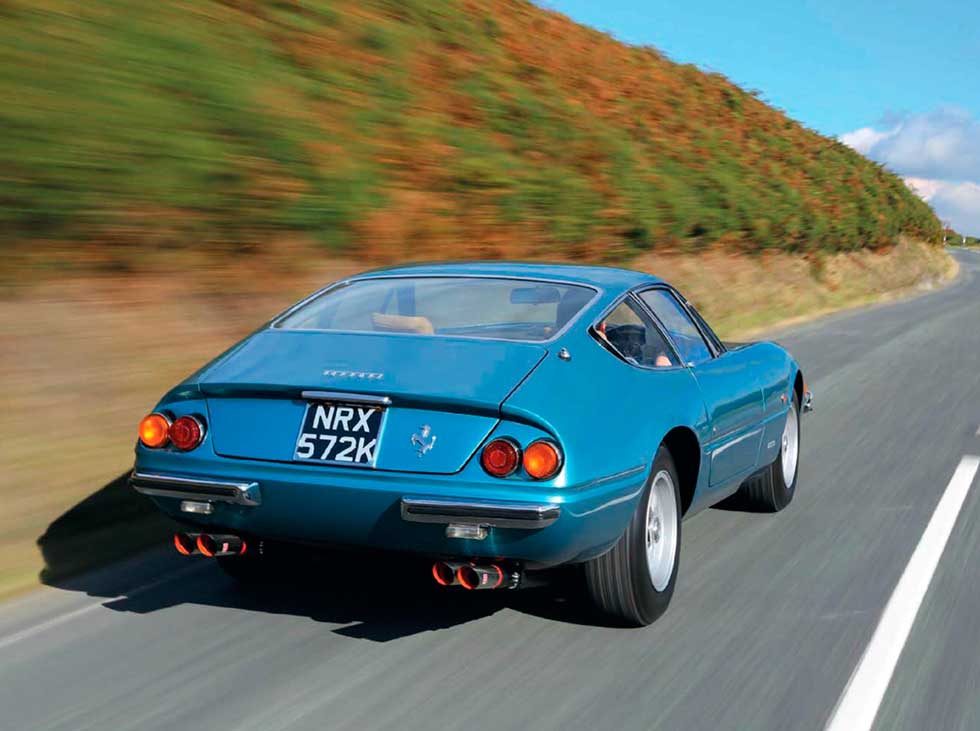
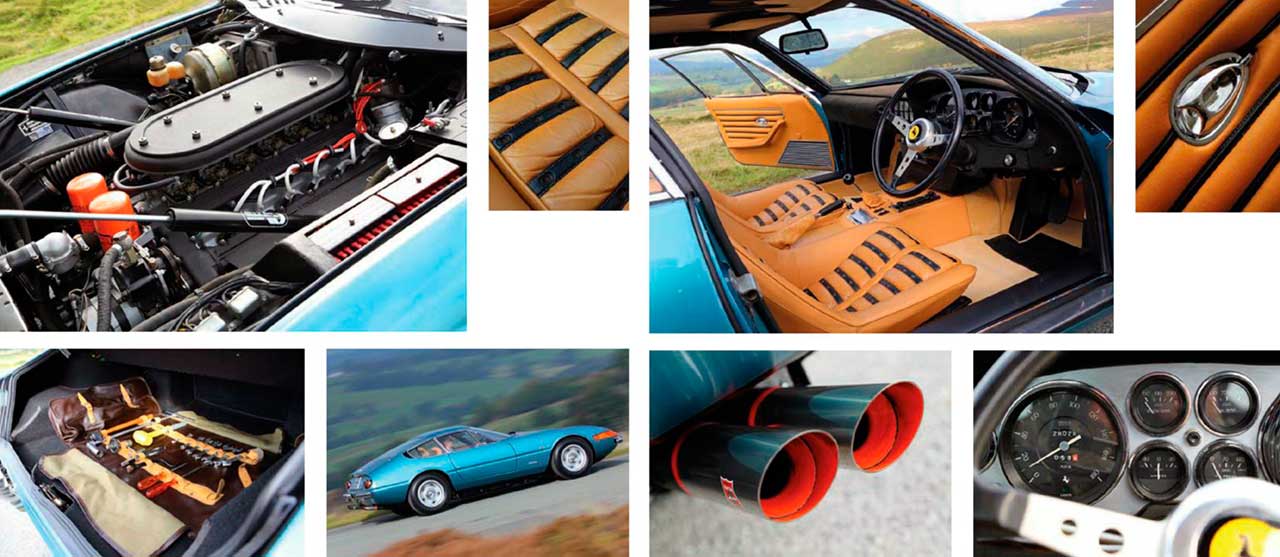
THE STYLIST Leonardo Fioravanti
The former Pininfarina design chief is keen to point out that the Daytona began as an off-the-books project: “Ferrari had the 275GTB, which was still quite new [launched at the 1965 Paris Salon], and it was supposed to remain in production for several more years. I never really liked it, though. It was nice in profile, but too pencil-like when you saw one in a three-quarter view. I had in mind something different and in [December] 1966, we had a couple of chassis in the factory.
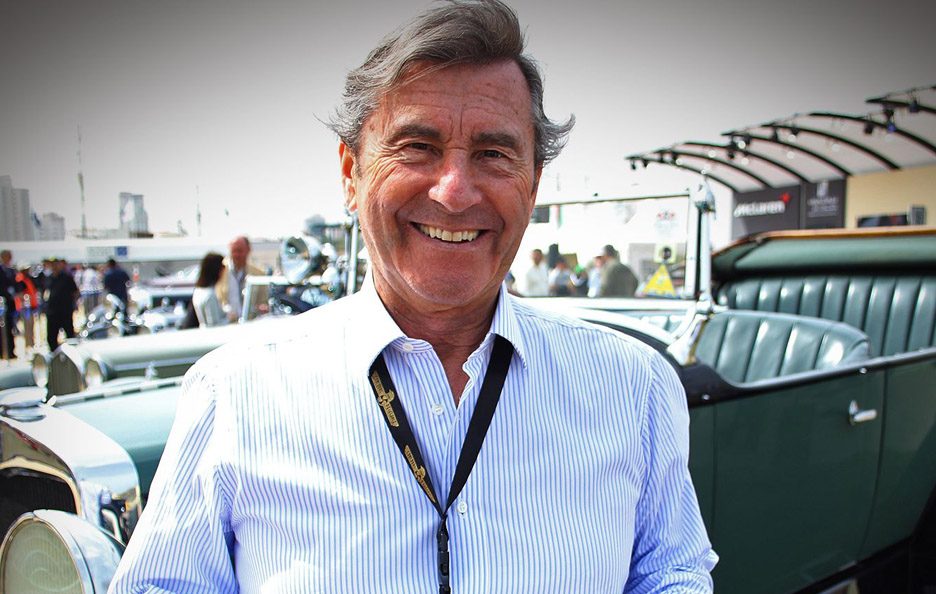
Normally, they were just bare frames, but these already had their V12 engines and suspension. “When I saw them I had this incredible idea.
I realised that there was the possibility of doing a very special car. I don’t know what inspired me but seeing those chassis did something! When my ideas were shown to Mr Ferrari, he liked what I had done and he asked for a 1:1 model.
Il Commendatore saw that and was pleased, but suggested the track was not wide enough so we added maybe 6mm to the front and also to the back. And that is how it came out.”
THE SPECIALIST Iain Tyrrell
Marque expert Tyrrell has three decades’ experience of all things Daytona, as a restorer and dealer. “The market is reasonably buoyant, but it has receded by about 10% over the past twelve months,” he explains. “If you go back to early 2016, fixed-head cars were going for about £700,000. I think a few people were a bit too ambitious with their prices, and there was a period when a lot of cars were being advertised. But demand is still there for proper examples so I think there is plenty of room for it to move back upwards, especially when you consider the prices of 275GTBs these days. I would add that there’s a slight premium for right-hand-drive cars in countries such as the UK, Hong Kong, Singapore, Malaysia and Australia.”
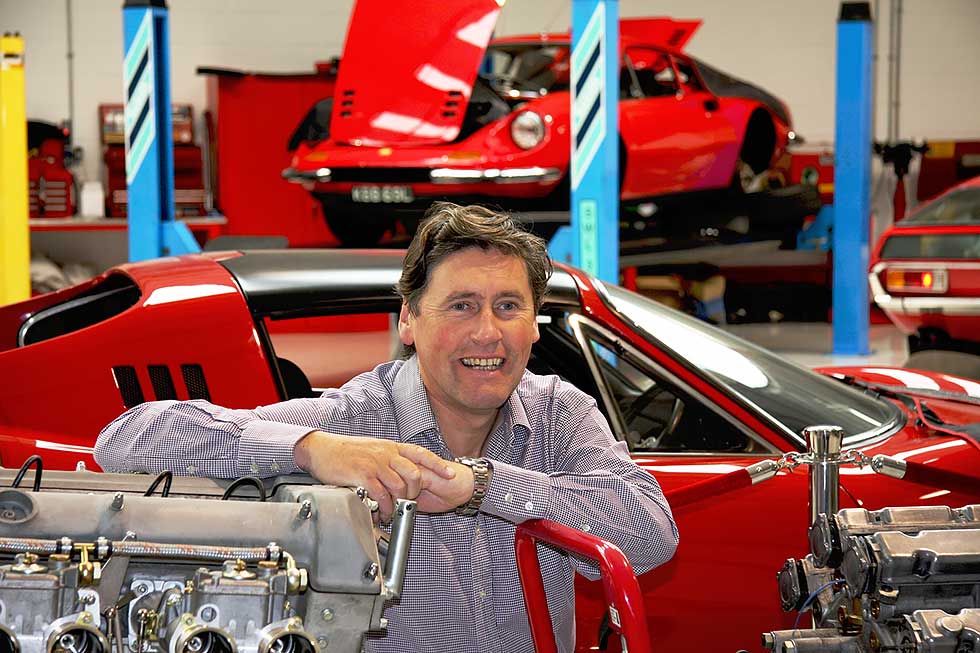
And is there much difference in price between first-generation cars with Plexiglas light covers and later pop-ups? “Perhaps, but it’s marginal. It’s all down to personal preference, after all. Fioravanti designed the car with Plexiglas covers, but I personally think the Daytona looks much better with the pop-up lamps. It’s also worth remembering that there were subspecies of Plexiglas cars, the first featuring ally door skins rather than steel and so on. All of these things can affect values.”





